Garlic is a popular herb that is widely used in cooking and has numerous health benefits. It is a member of the Allium family, which includes onions, shallots, and leeks. Garlic has a unique flavor and aroma that is prized by chefs and home cooks alike. Understanding the Garlic Plant Growth Stages is essential for successful cultivation.

The garlic plant has six main growth stages: germination, vegetative growth, reproductive stage, bulb maturation, harvesting stage, and post-harvest handling. Each stage is critical to the overall growth and development of the plant. The germination stage is the first stage of growth, where the garlic clove begins to sprout. The vegetative growth stage is where the plant grows leaves and stems. The reproductive stage is where the garlic plant produces scapes and flowers. The bulb maturation stage is where the garlic bulb develops and grows. The harvesting stage is where the garlic is ready to be harvested, and the post-harvest handling stage is where the garlic is cured and stored.
Key Takeaways
- Garlic has six main growth stages that are essential for successful cultivation.
- Understanding the growth stages of the garlic plant is crucial for proper care and management.
- Each stage of the garlic plant’s growth is critical to the overall development of the plant.
Garlic Botanical Profile
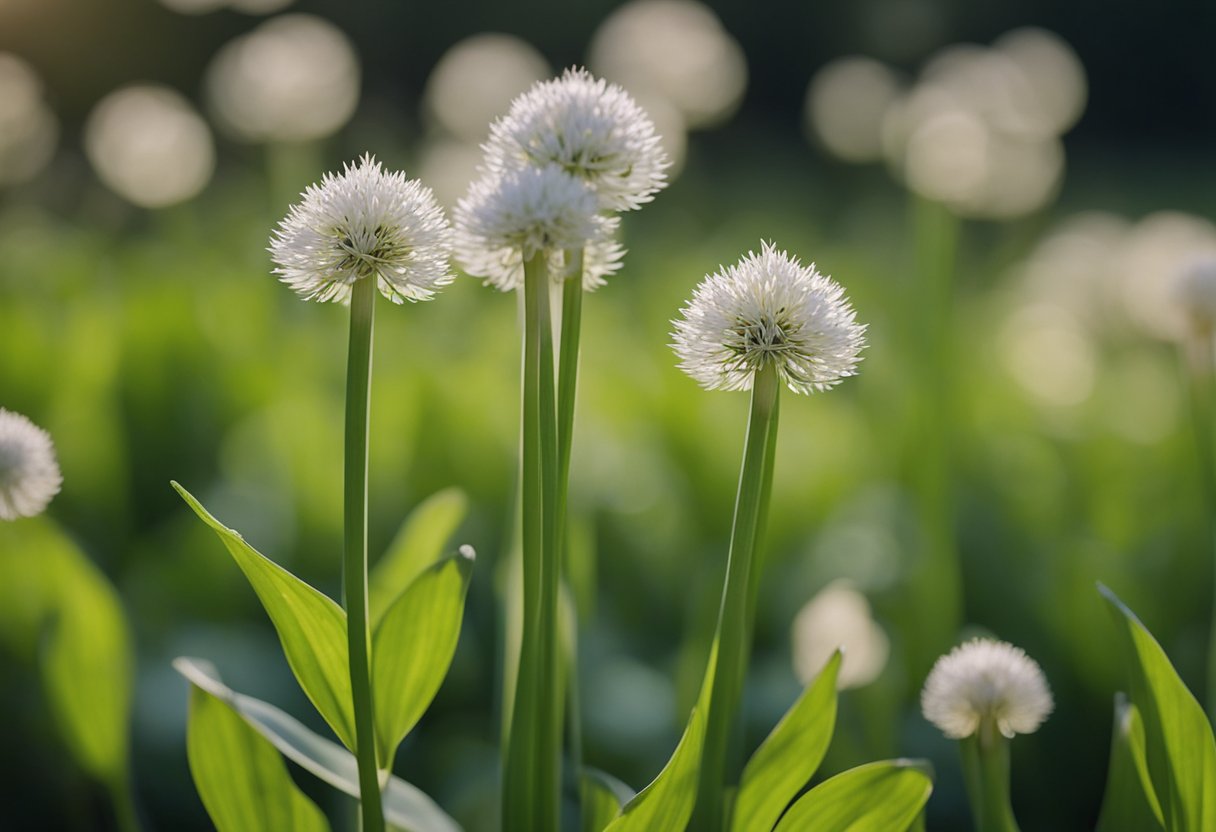
Garlic, scientifically known as Allium sativum, is a member of the Allium family, which also includes onions, shallots, and chives. It is a perennial plant that is usually grown as an annual crop. Garlic is a bulbous plant that grows up to 2 feet tall. The bulbs are made up of cloves, which are the part of the plant that is commonly used for cooking.
Garlic is an easy plant to grow and can be planted in the fall or spring. It prefers well-drained soil and full sun. Garlic is a hardy plant and can withstand cold temperatures, making it an ideal crop for colder climates.
Garlic is known for its pungent aroma and flavor, which is due to the presence of sulfur compounds. These compounds are also responsible for the health benefits associated with garlic, including its ability to lower cholesterol, boost the immune system, and improve heart health.
Garlic has a long history of use in both culinary and medicinal applications. It has been used for centuries in traditional medicine to treat a variety of ailments, including infections, respiratory problems, and digestive issues. In cooking, garlic is used to add flavor to a wide range of dishes, including soups, stews, sauces, and marinades.
Garlic is a versatile plant that is easy to grow and has a wide range of culinary and medicinal applications. Whether you are a seasoned gardener or a beginner, garlic is a great crop to add to your garden.
Germination Stage
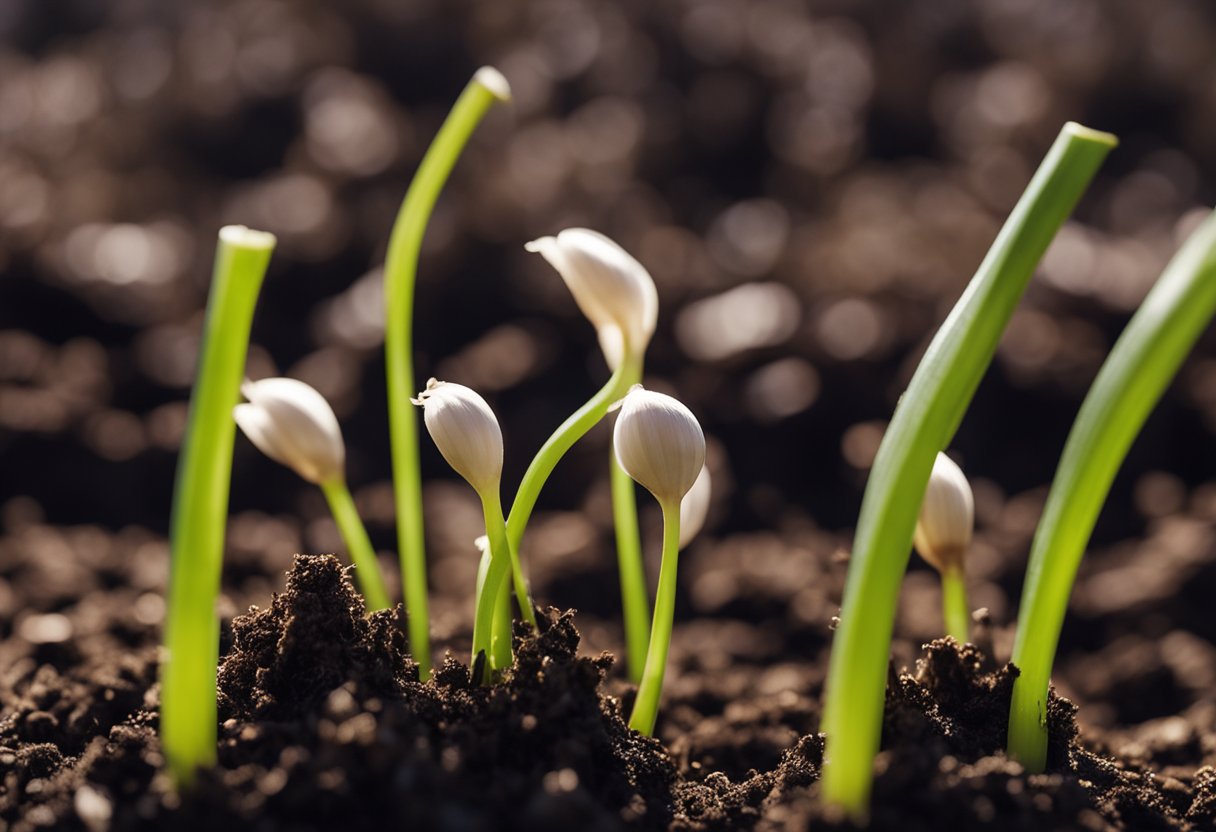
Garlic germination is the first stage in the life cycle of the garlic plant. This stage is crucial as it sets the foundation for the rest of the growth stages. During this stage, the seed clove begins to grow roots and shoots, which will eventually develop into a mature garlic bulb.
Seed Clove Preparation
Before planting the seed clove, it is important to select high-quality cloves. Look for cloves that are firm, plump, and free from any signs of damage or disease. It is also important to choose cloves that are of a good size, as larger cloves tend to produce larger garlic bulbs.
Once the cloves have been selected, they should be separated from the garlic bulb and the papery skin should be removed. It is important to handle the cloves gently to avoid damaging them.
Root Development
After the seed clove has been planted, it will begin to develop roots. The roots will grow downwards into the soil, anchoring the plant and absorbing water and nutrients.
During this stage, it is important to keep the soil moist but not waterlogged. Overwatering can cause the cloves to rot, while underwatering can cause the roots to dry out.
Once the roots have developed, the plant will begin to grow shoots above the soil. The next growth stage is the green/spring garlic stage, where the plant begins to produce leaves and stems.
Vegetative Growth
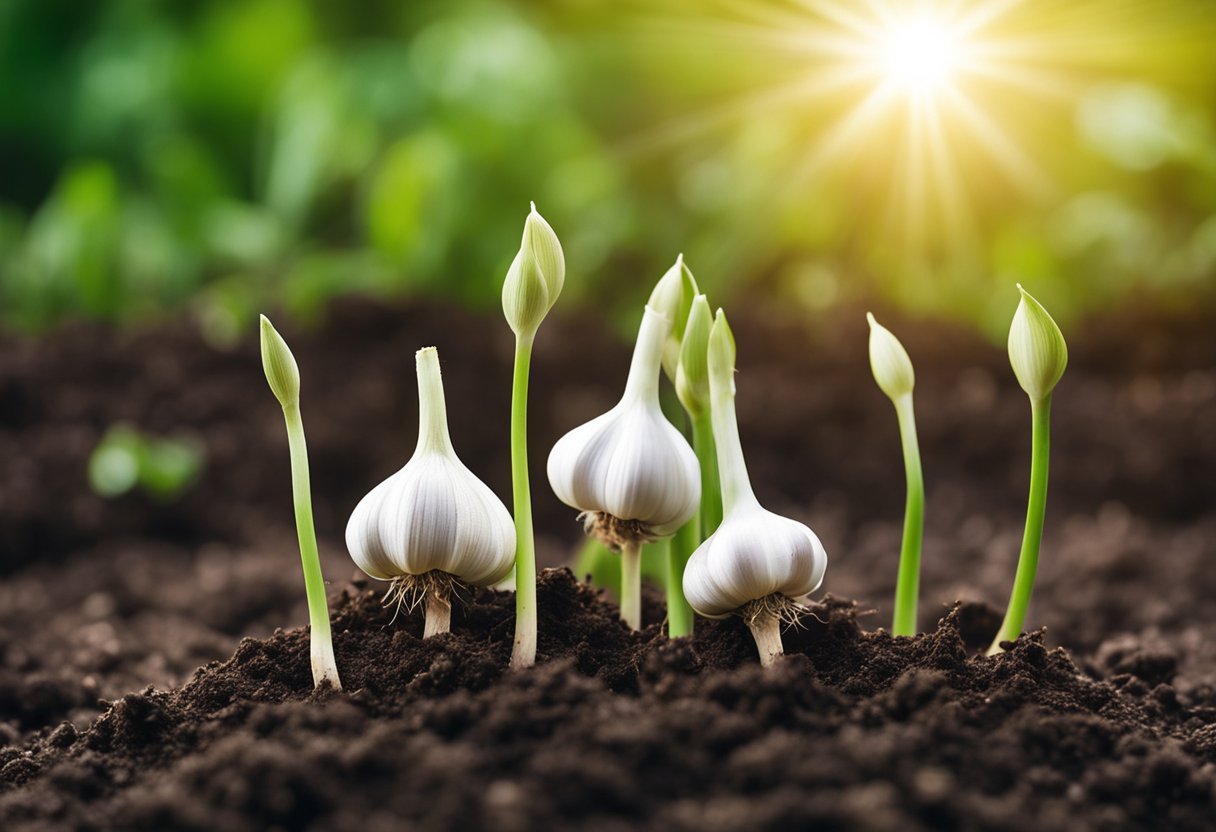
As a garlic plant grows, it goes through distinct stages of development. The first stage is the vegetative growth stage, which is characterized by the formation of leaves and the development of the bulb.
Leaf Formation
During the vegetative growth stage, the garlic plant produces a series of leaves. These leaves emerge from the base of the plant and grow upward. As the plant grows, the leaves become longer and wider, and they begin to take on a characteristic flat, strap-like shape.
Bulb Development
As the garlic plant continues to grow, it begins to develop a bulb. The bulb is the part of the plant that is used for culinary purposes, and it is what gives garlic its characteristic flavor and aroma.
At first, the bulb is small and undeveloped. However, as the plant continues to grow, the bulb begins to expand and take on a more rounded shape. As the bulb grows, it begins to divide into individual cloves, which will eventually be harvested and used for cooking.
The vegetative growth stage is a critical period in the life cycle of a garlic plant. During this stage, the plant lays the foundation for the development of a healthy, robust bulb, which will ultimately be used for culinary purposes.
Reproductive Stage
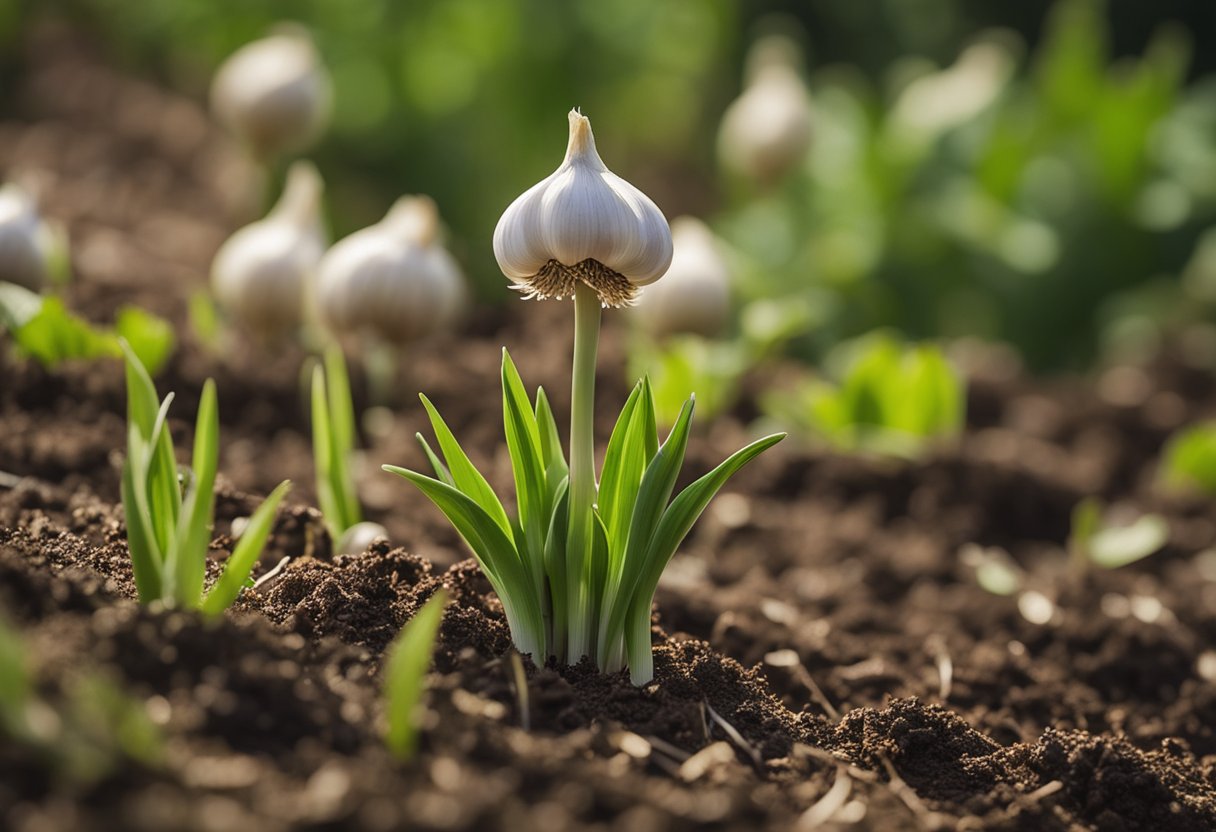
The reproductive stage of garlic plant growth is marked by the emergence of scapes and flowering. During this stage, the garlic plant begins to allocate more of its resources towards reproduction rather than leaf and bulb growth.
Scape Emergence
Garlic scapes are the long, curly stalks that emerge from the top of the garlic plant during the reproductive stage. These scapes are actually the garlic plant’s flower stalks and can grow up to several feet tall.
It is important to remove the scapes from the garlic plant as soon as they emerge. This allows the plant to focus its energy on bulb growth rather than flower production. Additionally, removing the scapes can prevent the garlic bulbs from becoming misshapen or stunted.
Flowering
If left to grow, the garlic scapes will eventually produce small, white or pink flowers. However, allowing the garlic plant to flower can reduce the size and quality of the garlic bulbs.
It is recommended to remove the garlic scapes before they begin to flower. This will ensure that the garlic bulbs reach their full potential and are of the highest quality.
The reproductive stage of garlic plant growth is an important phase in the plant’s life cycle. By removing the scapes and preventing flowering, gardeners can ensure that their garlic bulbs are of the highest quality and size.
Bulb Maturation
Once the garlic plant has gone through the various stages of growth, it enters the bulb maturation stage. This stage is the final stage of the garlic life cycle, and it is the most crucial stage for garlic growers.
During the bulb maturation stage, the garlic plant stops producing new leaves and focuses all its energy on the bulb. The leaves start to turn yellow and dry out, signaling that the bulbs are almost ready for harvest. At this point, the garlic bulbs have reached their maximum size and have formed a protective layer of skin around them.
To ensure that the garlic bulbs mature properly, it is important to provide them with adequate nutrients and water. Additionally, it is important to keep the garlic bed weed-free and well-drained.
Once the garlic bulbs have reached full maturity, they are ready to be harvested. The timing of the harvest is crucial, as harvesting too early will result in small bulbs, while harvesting too late will result in the bulbs splitting and deteriorating.
The bulb maturation stage is the final stage of the garlic life cycle and is crucial for the production of high-quality garlic bulbs. By providing the garlic bulbs with proper care and attention during this stage, growers can ensure a bountiful harvest of healthy and flavorful garlic bulbs.
Harvesting Stage
Harvest Timing
Knowing when to harvest garlic is crucial to achieving the best flavor and storage life. Garlic is ready for harvest when the leaves start to turn yellow and dry out. Typically, garlic is harvested in late spring or early summer, depending on when it was planted.
It is recommended to harvest garlic when about one-third to one-half of the leaves have turned yellow. Waiting too long to harvest can result in overripe bulbs that are difficult to peel and have shorter storage life. On the other hand, harvesting too early can result in underdeveloped bulbs that are small and not fully mature.
Curing Process
After harvesting, it is important to cure the garlic bulbs before storing them. Curing allows the garlic to dry out and develop a protective layer that extends its shelf life. To cure garlic, hang the bulbs in a warm, dry, and well-ventilated area for two to three weeks.
During the curing process, the garlic bulbs should be kept out of direct sunlight and away from moisture. Once the bulbs are fully cured, remove the outer layers of papery skin and trim the roots and stems. Store the garlic bulbs in a cool, dry, and dark place with good air circulation.
Harvesting and curing garlic properly are essential for achieving the best flavor and storage life. By following these simple steps, you can enjoy delicious garlic throughout the year.
Post-Harvest Handling
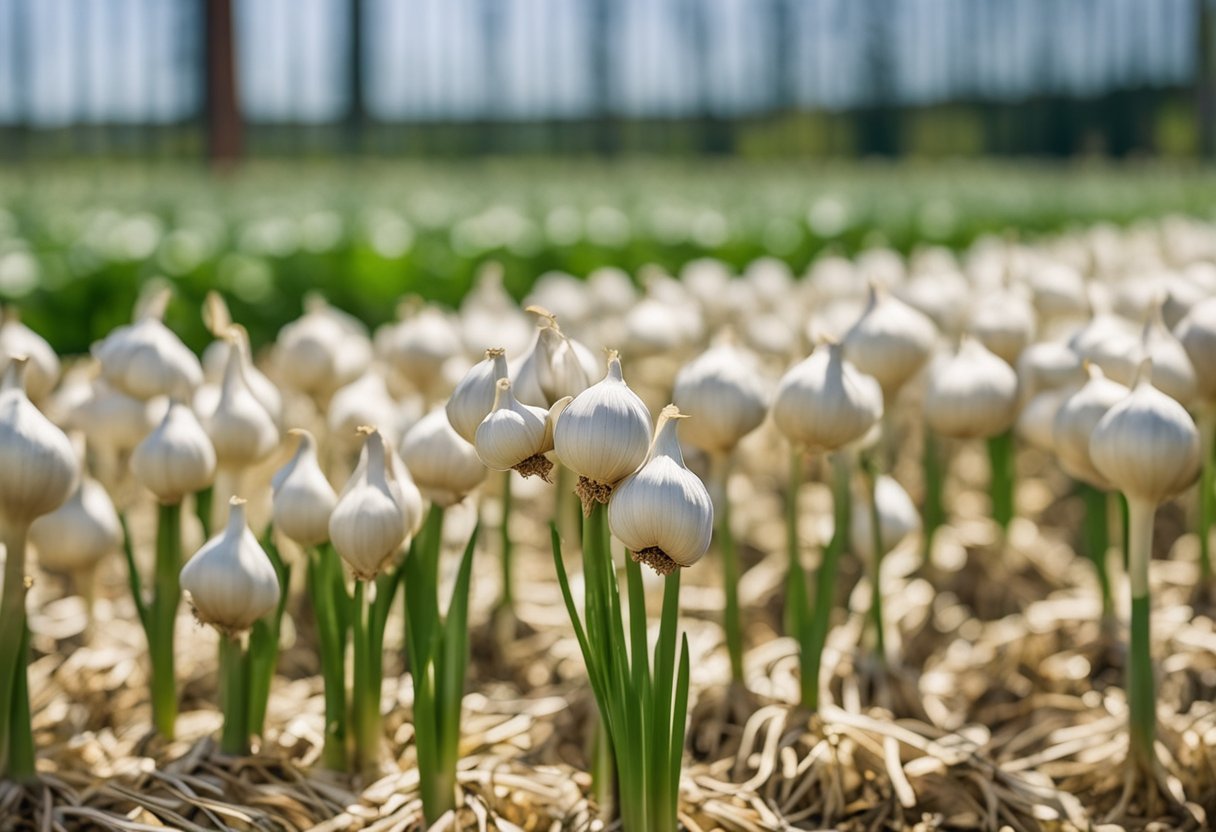
Storage Conditions
After harvesting garlic, it is important to store it properly to ensure that it remains fresh and flavorful. Garlic should be stored in a cool, dry place with good air circulation. The ideal temperature for storing garlic is between 60 and 65 degrees Fahrenheit, with a relative humidity of 60 to 70 percent.
It is important to avoid storing garlic in the refrigerator, as this can cause the cloves to sprout and lose their flavor. Instead, store garlic in a well-ventilated area, such as a pantry or a cool basement. Garlic can also be stored in mesh bags or in a garlic keeper, which is a ceramic container with ventilation holes that allows air to circulate around the garlic.
Shelf Life
The shelf life of garlic can vary depending on how it is stored. Garlic that is stored properly can last for several months, while garlic that is not stored properly can spoil quickly. When stored in the right conditions, garlic can last for up to six months.
To ensure that garlic stays fresh for as long as possible, it is important to inspect it regularly for signs of spoilage. If garlic begins to sprout or develop mold, it should be discarded. Garlic that has begun to sprout can still be used, but it may have a milder flavor and a softer texture than fresh garlic.
Proper post-harvest handling is crucial for maintaining the quality and flavor of garlic. By storing garlic in a cool, dry place with good air circulation, and inspecting it regularly for signs of spoilage, you can ensure that your garlic stays fresh and flavorful for as long as possible.
Pest and Disease Management
As with any crop, garlic is susceptible to pests and diseases. However, there are several measures that can be taken to prevent and manage these issues.
Pests
Some common pests that can affect garlic include onion thrips, leafminers, and bulb mites. To prevent infestations, it is important to keep the garlic field clean and free of debris. Regular weeding and crop rotation can also help prevent the buildup of pests in the soil.
If an infestation does occur, there are several organic pest control methods that can be used. These include neem oil, insecticidal soap, and garlic spray. These methods are effective at controlling pests without harming the garlic plant or the environment.
Diseases
Garlic is also susceptible to several diseases, including white rot, purple blotch, and downy mildew. To prevent the spread of disease, it is important to practice good sanitation in the field. This includes removing infected plants and debris, as well as avoiding overhead irrigation.
There are also several organic disease control methods that can be used. These include copper fungicides, sulfur dust, and compost tea. These methods can help prevent the spread of disease and keep the garlic plants healthy.
By following these pest and disease management practices, you can ensure a healthy and productive garlic crop.
Soil and Climatic Requirements
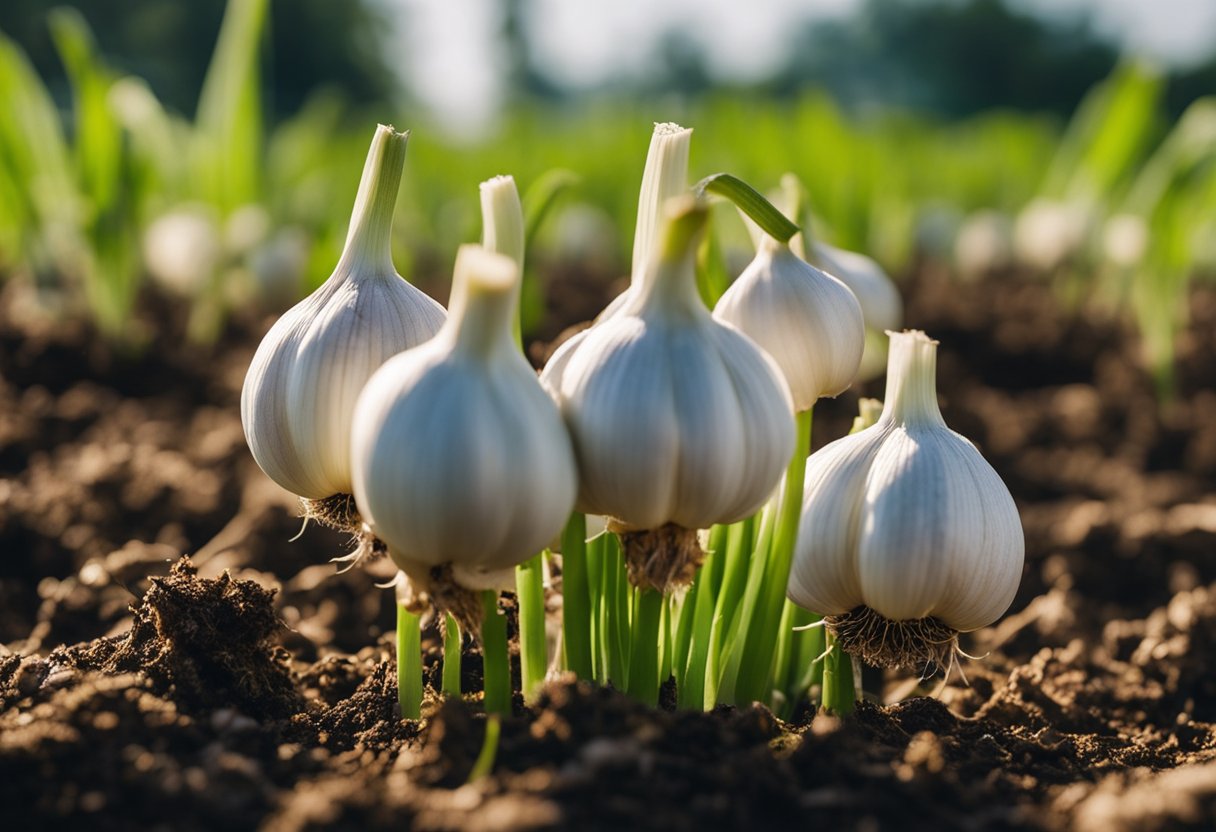
To grow garlic successfully, it is important to provide the right soil and climatic conditions. Garlic is a hardy crop that can grow in a wide range of soil types. However, it prefers well-drained soil that is rich in organic matter. The ideal pH range for garlic cultivation is between 6.0 and 7.0.
Garlic requires a cool climate to grow, with temperatures ranging between 13°C to 24°C (55°F to 75°F) during the growing season. It can tolerate frost but not extreme heat. If the temperature rises above 30°C (86°F), the garlic plants will start to wilt and the bulbs will not develop properly.
It is important to choose a site that receives plenty of sunlight. Garlic requires at least six hours of direct sunlight each day. It is also important to plant garlic in a location that is sheltered from strong winds.
To ensure optimal growth, it is recommended to prepare the soil before planting. This can be done by adding compost or well-rotted manure to the soil. It is also important to ensure that the soil is free from weeds and other debris that could interfere with the growth of the garlic plants.
To grow garlic successfully, it is important to provide well-drained soil that is rich in organic matter, a cool climate with temperatures ranging between 13°C to 24°C (55°F to 75°F), plenty of sunlight, and a location that is sheltered from strong winds. With the right soil and climatic conditions, garlic can be a rewarding and easy crop to grow.
Fertilization and Irrigation Practices
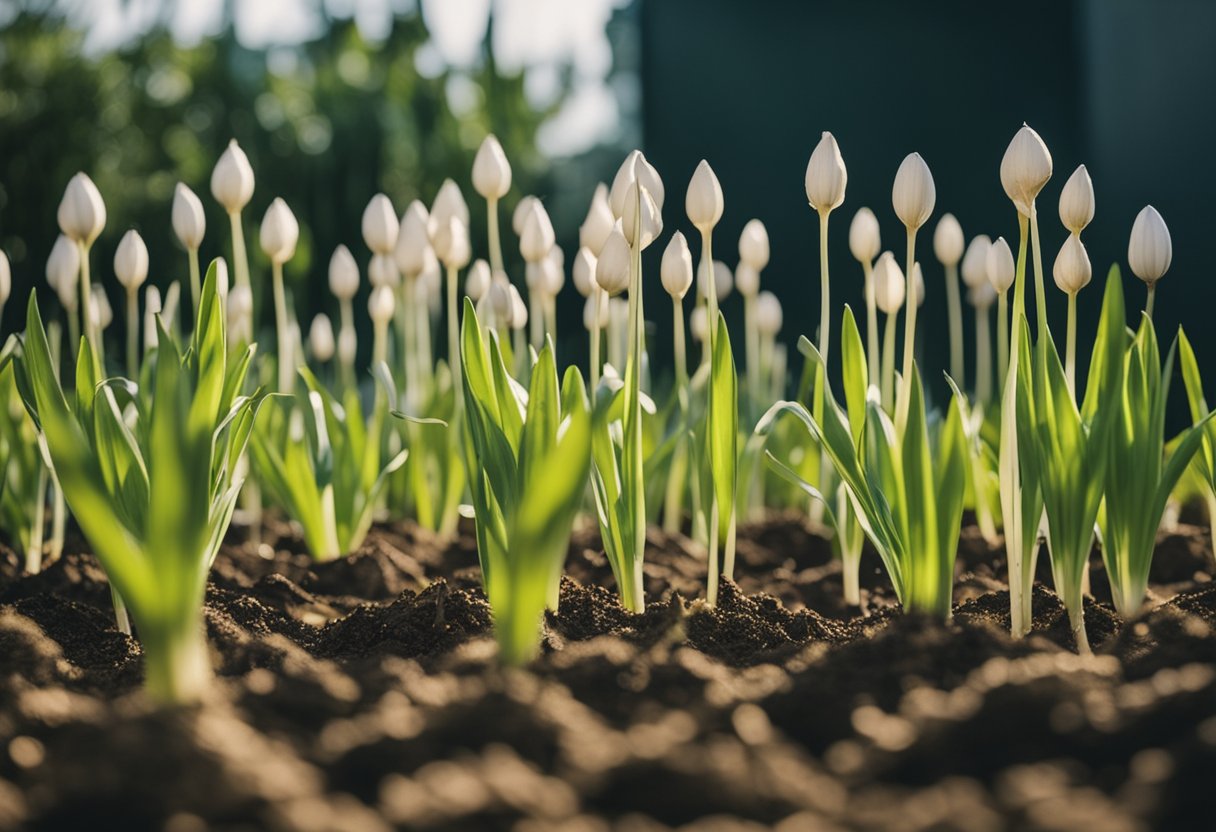
As a garlic plant grows, it requires proper fertilization and irrigation practices to ensure healthy growth and development. In this section, I will discuss the best practices for fertilizing and irrigating garlic plants.
Fertilization
Garlic plants require proper nutrients to grow, and fertilization is a key factor in providing these nutrients. Organic fertilizers such as compost, manure, and bone meal are the best options for garlic plants. These fertilizers provide a slow-release of nutrients that are essential for the plant’s growth.
It is important to apply the fertilizer at the right time during the plant’s growth cycle. The best time to apply fertilizer is during the early stages of growth, when the plant is establishing its roots. Fertilizer should be applied again during the bulb formation stage to ensure that the plant has all the nutrients it needs to produce healthy bulbs.
Irrigation
Garlic plants require consistent moisture levels to grow properly. Overwatering or underwatering can lead to stunted growth and poor bulb development. The best way to ensure proper moisture levels is to use a drip irrigation system. This system delivers water directly to the root zone and reduces the risk of overwatering.
It is important to monitor the moisture levels in the soil to ensure that the garlic plants are receiving the right amount of water. Soil should be kept moist but not waterlogged. A layer of mulch can help to retain moisture in the soil and reduce the need for frequent watering.
Proper fertilization and irrigation practices are essential for the healthy growth and development of garlic plants. By following these best practices, you can ensure that your garlic plants produce healthy bulbs and provide you with a bountiful harvest.
Also Read | Why Your Sweet Corn Plant Leaves Are Turning Brown: Common Causes and Solutions
Frequently Asked Questions
How do you identify the different stages of garlic growth?
As garlic grows, it goes through six different stages. These stages are germination, vegetative growth, bulbing, curing, harvesting, and storage. The germination stage is when the garlic clove starts to sprout roots and shoots. Vegetative growth is when the garlic plant grows leaves and stems. Bulbing is when the garlic plant starts to form bulbs. Curing is when the garlic is dried to extend its shelf life. Harvesting is when the garlic is pulled out of the ground. Finally, storage is when the garlic is kept in a cool, dry place until it is ready to be used.
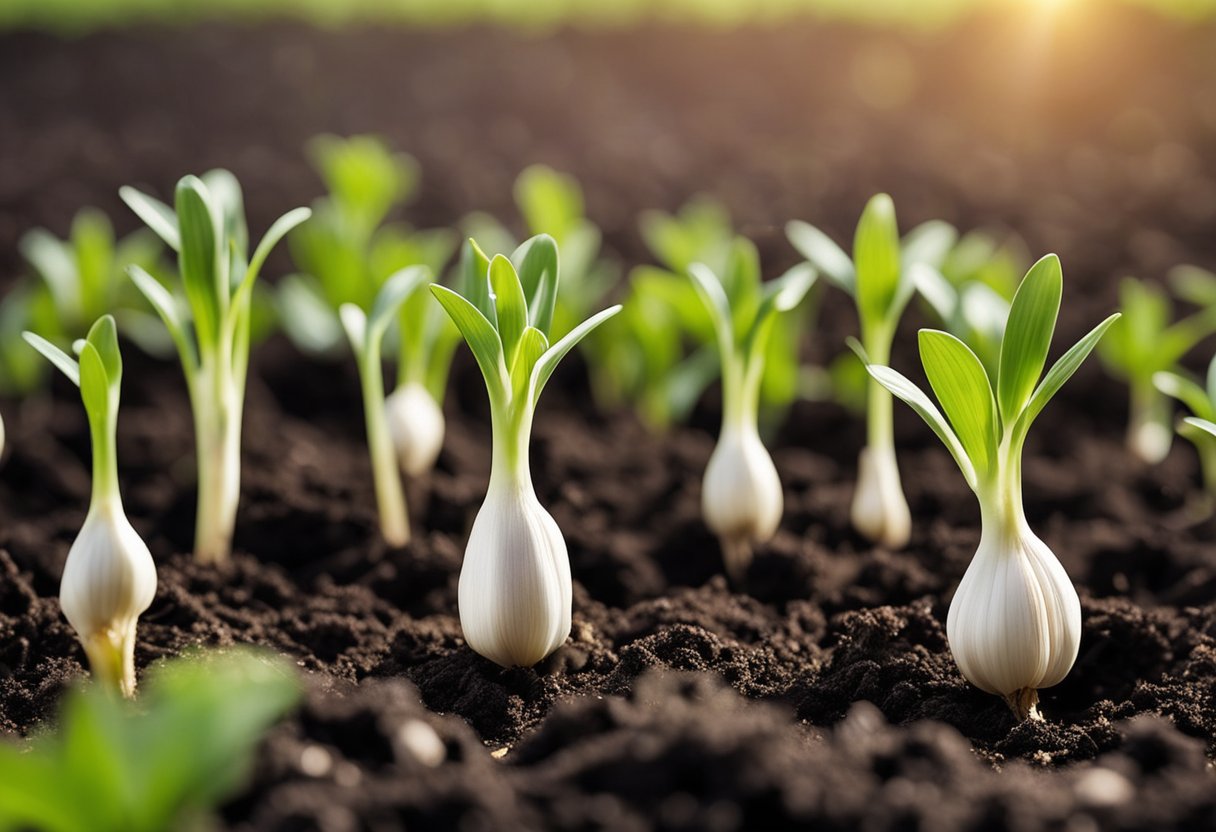
What is the optimal time to harvest garlic?
The optimal time to harvest garlic is when the leaves start to turn yellow and die back. This usually happens in mid to late summer, depending on the variety of garlic and the growing conditions. You can also tell if the garlic is ready to harvest by checking the bulbs. If the bulbs are large and firm, they are ready to be harvested.
How can you tell if garlic has spoiled during its growth?
Garlic can spoil if it is not grown in the right conditions. Signs of spoiled garlic include mold, rot, and a foul smell. To prevent garlic from spoiling, it is important to grow it in well-draining soil, water it regularly, and keep it in a cool, dry place after it has been harvested.
What are the ideal growing conditions for garlic?
Garlic grows best in well-draining soil that is rich in organic matter. It also needs plenty of sunlight, so it should be planted in a spot that gets at least six hours of direct sunlight per day. Garlic should be watered regularly, but not over-watered, as this can lead to root rot. It is also important to keep the soil pH between 6.0 and 7.0.
How long does a full garlic growth cycle take?
The full garlic growth cycle takes about 8 to 9 months. This includes the time it takes for the garlic to sprout, grow leaves and stems, form bulbs, and dry out for storage.
At which stage of growth are garlic scapes and flowers produced?
Garlic scapes and flowers are produced during the vegetative growth stage of garlic growth. This is when the garlic plant is growing leaves and stems. Garlic scapes are the curly, green shoots that grow out of the top of the garlic plant. They can be harvested and used in cooking, or they can be left on the plant to produce flowers and seeds.